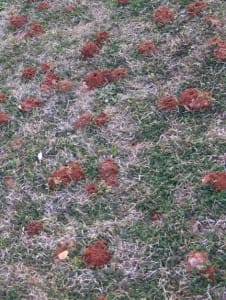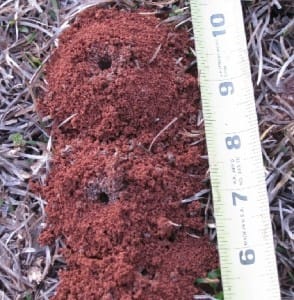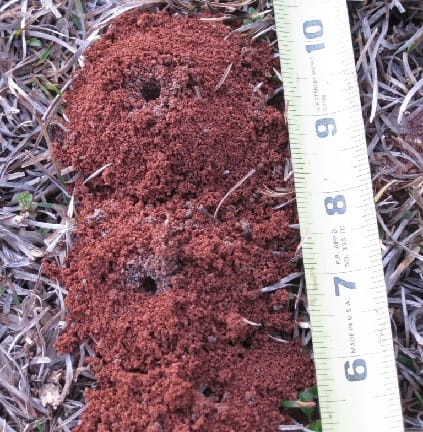
Ground or Digger Bees Attack Lawns
The first sign of ground or digger bees in lawns may be strange little mounds of soil with a hole nearby. The ground bees will be flying over this area. Ground bees are solitary bees that dig and nest in the ground. These bees live one per hole but there may be many holes in an area creating ground bee communities. There are many types of ground bees that vary in color and range from one-half to three-quarter inch in length. Some types of solitary wasps live like this as well.
Female ground bees dig nests in the ground up to six or so inches deep in which to raise young. The bees pile earth around the sides of the hole. These bees can be very active in March and April. The female ground bee stocks the nest with pollen and nectar to feed the young bees. Some solitary wasps stock their nests with insects.
Ground bees typically cause little problem. The digging should not be enough to damage the lawn. The bees are not very aggressive and probably will not sting. You should be able to work and mow grass around them with few problems. People that are allergic to bee stings may want to be cautious when working around the bees.

We do not recommend chemical controls for ground bees or wasps. These bees can be beneficial – serving to pollinate plants or destroy harmful insects. They will probably only be around for four to six weeks and then disappear until next year.
If you must control them, use cultural controls.
- Ground bees like dry soils. Water the soil when bees first become active. Apply one inch of water once a week if it does not rain.
- Ground bees nest in dry areas where the grass is thin. Find and correct the problems making the turf thin. This may involve soil sampling, irrigation, soil aeration or other practices.
- Find ways to thicken the turf in these areas to reduce ground bee problems. Know the needs of the turf grass and meet them!
- In areas that will not grow grass, mulch the area.
If you must use a pesticide, watch during the day to see where the holes are located. After dark, dust these areas with carbaryl (sold under the name Sevin and other names) dust. A dust insecticide should cling to the bee’s body better than a spray. Keep people and pets out of the area while it is being treated.
The bees are not generally harmful and pesticides are toxic. The cure may be worse than the problem. Try to put up with the bees if you can. These bees may be difficult to control and may return year to year. If you have ongoing problems with them, follow all recommendations very carefully. See this site where I found much of this information http://www.ces.ncsu.edu/depts/ent/notes/O&T/lawn/note100/note100.html
There is one large caution in connection with ground bees and wasps. Ground bees are not aggressive but can look like other bees and wasps that are very aggressive and harmful. Make absolutely certain that you are not dealing with a yellow jacket or bumble bee nest. Both of these insects can literally cover you with stings very quickly. They can also have extremely large nests in Georgia. If you ever get into trouble with these, run until you escape them. Running inside may help. Do not stop to swat, roll on the ground, etc.
Before you begin control of any stinging insect, make certain of your pest. This or other websites can help you identify the lawn invader http://aces.nmsu.edu/ces/plantclinic/documents/t-10-waspsandbees.pdf.
One difference between ground bees and other bees or wasps is that ground bees live by themselves and make many holes in the ground. Yellow jackets and bumble bees have many insects per hole. Use the following from Dr. Will Hudson, UGA Entomologist, as a guide for identification.
Many holes with one 1 bee per hole = solitary bees (like ground bees) that sting only as a last resort.
One hole, many bees = social bees (like yellow jackets and bumble bees). Keep away! These are non-reproductive workers that will sacrifice themselves in defense of the nest.
For insects other than ground bees, you may want to hire a pest control company or a wildlife removal company. They should have the training and equipment to do the job properly.
Please share this information with others in the landscape industry. For more information:
Call your local Extension Agent at (800) ASK-UGA1 or locate your local Extension Office
